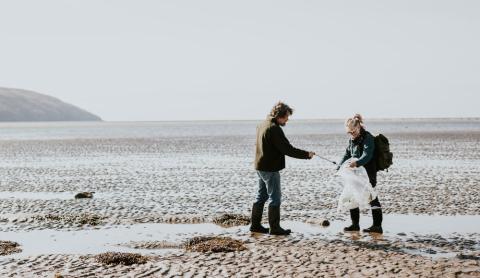Hold the conversation
Our conversation guide will help you get started – whether you’ve got a coffee break to chat in or a workshop to run.
Start talking


Your Nature at Work Conversation Guide
You’ve done some exploring and you’ve reached out to colleagues, and now you’re thinking about how to hold the conversation. There are lots of ways to do it, here are some tools and tips to help you find what works for you.
Welcome and check-in

Conversation holder checklist
- Welcome people and give a quick recap of what the conversation is all about
- Share the specific way-in you’re focussing on
- Set expectations of where you’re all looking to get to
- If you want to, start the conversation with a question to get people thinking
- Share an answer to the question yourself, to give people time and prompt their thinking.

What might that look like?
- Thank you for coming today, we’re going to be exploring how we might bring more nature into our organisation
- We’ll look at how our organisation impacts on nature now, what nature friendly things we already do and where there might be opportunities to do more
- There are 5 ways we can think about our relationship with nature: our workplace, finances, policies, supply chain and our people. Today we’re going to be focussing on <your chosen topic e.g. our workplace>
- Our workplace is all about what we do on the ground: the places we own or influence, how we go about our on the ground activities like travel or transporting goods
- An example of how we bring nature in/how we might bring nature in is <an example from your organisation or another>.

Setting expectations.
- This conversation is a first step to exploring what more we could do
- We won’t get to all the answers but we’ll build our understanding of how we touch upon nature and where there are opportunities to explore in more depth *

A quick question to start the conversation.
- Why did you want to join this conversation and where are you hoping we might get to?
Tips.
- Check-in questions like the one above are good ways to bring people into the conversation, introduce people who might not know each other and strengthen people’s commitment to what you’re doing
Resources to help.
Mapping what you do now and opportunities

Conversation holder checklist.
Introduce that you’re now going to start thinking about your <e.g. workplace> - mapping what you do now and spotting opportunities
Using the 5 ways in discussion guide as a structure, give people time to think about each question and the prompts that sit underneath.
To help you capture the conversation, you may want to use a shared flipchart and post-its or an online equivalent like Jamboard or Miro if meeting remotely.
Once people have had time to think and/or add post-its then come back up and discuss each question - giving everyone time to share their thoughts and capturing the discussion

What might that look like?
- We’re going to look at how we might create a more nature friendly workplace by asking:
- What does our workplace look like and how does it affect nature?
- What are we already doing for nature?
- What opportunities can we see?
- What questions are we holding?
- We’ll explore each of those questions, giving you some time to reflect and then coming back together to share where we’re getting to
Tips:
- You may want to take it a question at a time discussing each as you go, or you can give people time to consider all 4 upfront and then come back together to discuss each one
- Some questions will likely need more time e.g. what are we already doing, opportunities
- Questions and statements like the following are useful for helping people to explore their or to bring other people in:
- Can you say a little bit more about that
- Did anyone else have something similar?
Leave a little time at the end to summarise the discussion you’ve had e.g. I think I’ve heard <quick summary> is there anything I’ve missed?
Imagining what could be

Conversation holder checklist.
- Introduce the idea that in this part of the conversation, you’re going to imagine what it would look like for your organisation to really bring nature into your <e.g. workplace>
- Set up the future scenario and give people 2-3 minutes to capture their thoughts
- Suggest people do what they need to help imagine: turn off their screen if they need, go to a different table, and have a pen and paper to hand to capture thoughts
- After 2-3 minutes come back together and give everyone a chance to share what was coming up for them
- As a group reflect on what collective themes are - adding anything new opportunities or questions you’re holding onto the map you created in the previous exercise

What might that look like?
- Together we’re going to step into the future and imagine it’s 2034. You see an article about our organisation entitled ‘5 ways we brought nature into our workplace’.
- What are the headlines?
- What images or quotes accompany the article?
Tips.
- This is about giving people a different way into thinking about this and generating some energy and excitement, encourage people to go where their mind takes them and not to be held to what’s happening now
Starting from good
Starting from good
Why not look at what else is being done with your peers, either individually or as a business. Start by asking ‘What’s one nature friendly thing we admire from another organisation, what has our business done before?’ Build the discussion around why you admire it and what you could see it looking like if your business or team was to do something similar.
Here are some examples of companies you could look at:
- Faith in Nature
- Saracens
- M&S
- Finisterre
- Patagonia
- Ella’s Kitchen
- PWC
- PG Tips - Engaging Employees to Create a Sustainable Business
- WWF sustainable office guide
There are many more companies out there taking different actions for nature, be sure to take a look for any in your field
Finding a next step and closing the conversation

Conversation holder checklist.
- In the final part of the conversation, dedicate some time to discussing what a good next step would be
- Ask people to think about: What are the next steps to exploring the opportunities we’ve identified and answering the questions we’re holding? What’s one thing I could do? You might want to give people a couple of minutes to think or go straight into discussion
- Open up the conversation, allowing everyone to speak and capturing next steps as you go
- Summarise the conversation: what feel important next steps as a whole and what each person can do next
- Agree a next conversation or time to check in
- Thank people for coming
Tips.
- By opening up the conversation on next steps and encouraging people to think about what they could do you’re continuing to form the group and share the responsibility
- You may want to capture next steps in an easy way to share back - using a flip chart or something like Jamboard to capture important next steps on one side and what individuals can do next on the other
To get more technical
Go deeper
If you’d like to find out more about some of the topics we’ve mentioned in this guide, here are some links to start you off.
- Dasgupta Review, Economics of Biodiversity - Final Report - The Economics of Biodiversity: The Dasgupta Review - GOV.UK (www.gov.uk)
- Roadmaps to Nature Positive - Roadmaps to Nature Positive: Foundations for all businesses - World Business Council for Sustainable Development (WBCSD)
- Science-based Targets for Nature - The first science-based targets for nature – Science Based Targets Network
- Task Force for Nature-related Financial Disclosure - The Taskforce on Nature-related Financial Disclosures (tnfd.global)
- Natural Capital Guidance, Biodiversity Supplement - Biodiversity Guidance - Capitals Coalition
Take the next step.






